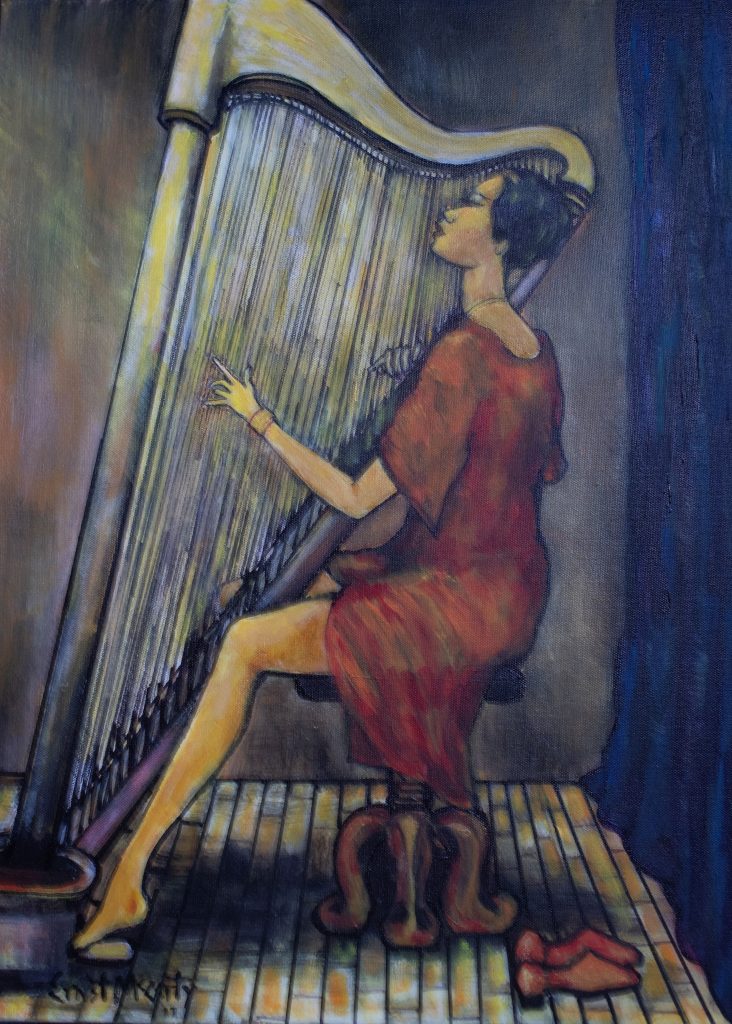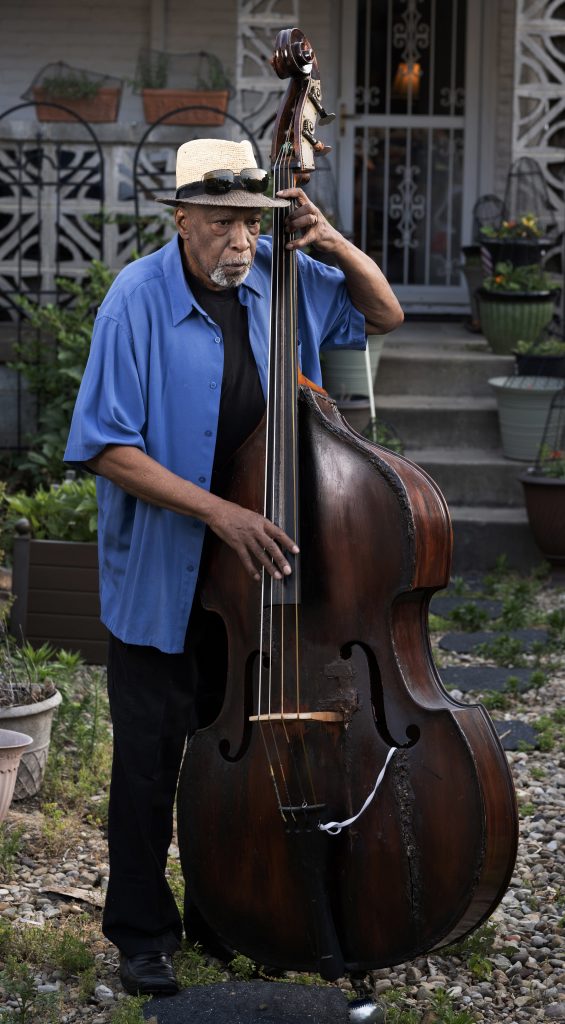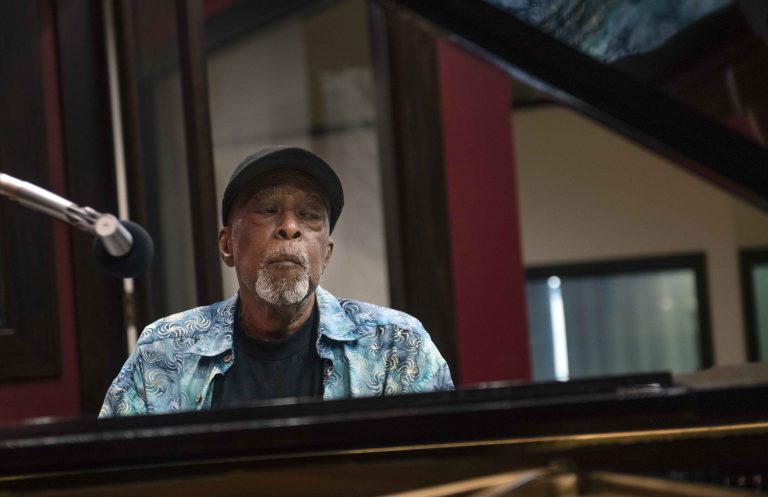“I have muses that demand things,” says the accomplished octogenarian.
By Nate Guidry
If Ernest McCarty, Jr., 82, had insisted on playing the clarinet in high school, it’s likely he would not have had the opportunity to travel the world, share the stage with Ike and Tina Turner, and spend weeks in Europe being treated like royalty while touring with Pittsburgh pianist Erroll Garner.
When McCarty arrived at the famed DuSable High School in Chicago, music director Captain Walter Dyett told a young McCarty that the band needed an upright bass player. “Bass or nothing” was how it was conveyed. It would have been unwise to question Dyett, an accomplished violinist and musical educator who had trained such incredibly talented young musicians as Nat King Cole, Bo Diddley, Dinah Washington, and many others.
“I’ve always had a love-hate relationship with the bass,” says McCarty, laughing as he sits on the front porch of his home in Pittsburgh’s Lawrenceville neighborhood. “My relationship with the bass started in high school. The instrument was big and physical, and I struggled with it.” After starting out on the piano and later the violin, McCarty reluctantly switched to the upright bass. “I was five feet tall, and the bass was six feet. Eventually, I got into it because I couldn’t bring a failing grade home. Playing the bass taught me how to embrace my obligations,” he said.
McCarty, who is also a self-taught painter, grew up on Chicago’s South Side. His mother was a church pianist and conducted the Thomas A. Dorsey choir. Dorsey was instrumental in the development of gospel music, writing thousands of songs, including “Take My Hand, Precious Lord.”
I started drawing as a kid. I never had any formal training. I learned from looking at what other artists were doing. Most of my paintings have been since I’ve moved to Pittsburgh.
Ernest McCarty, Jr.

“Every Thursday, I would go downstairs, and in the living room, there might be Mahalia Jackson, Mighty Clouds of Joy, or Sam Cooke rehearsing,” says McCarty. “My mother was in that circuit. I was exposed to gospel and R&B at a young age, and when I got to high school, I was exposed to jazz.”
McCarty studied composition at Roosevelt University in Chicago. He performed in local groups, including a band called the “Jazzmen,” which also featured drummer Maurice White, co-founder of the seminal R&B group Earth, Wind & Fire. In 1962, McCarty went on the road with singer Oscar Brown Jr., eventually becoming the band’s music director. After several years with Brown, McCarty moved to New York to write plays. In 1970, he co-wrote the music and lyrics to the Off-Broadway production, “I Dreamt I Dwelt in Bloomingdale’s.”
Over the years, McCarty has written or co-written dozens of plays and musicals. After moving to Pittsburgh in 1993 with his wife, Patricia, he served as the artistic director for New Horizon Theater from 1994 to 2008. McCarty also found time to play the bass, performing with Paul Cosentino’s Boilermaker Jazz Band for more than two decades.
The entire time that I was with Erroll Garner, I thought about how blessed I was. There was no jive going on with Erroll. He was treated like a rock star: red carpet, and Rolls-Royce.
Ernest McCarty, Jr.
“One day [trombonist] Nelson Harrison brought Paul Cosentino over, and I joined his band. It was great. We played every weekend. We traveled to Europe and Korea twice,” McCarty remembers fondly.
The following interview has been edited for clarity and for length.
In high school, you started playing the bass. Who were some of your earliest influences?
Certainly, Milt Hinton, who Captain Dyett taught at [Chicago’s] Wendell Phillips High School. I also liked Oscar Pettiford and [Pittsburgh’s] Ray Brown. My idol, though, was [Pittsburgh-born] Paul Chambers. The way he kept the time and he was always dressed clean. I wanted to be like him.

McCarty at his home in Lawrenceville on June 17, 2023. His career as a classical and jazz bassist spans six decades. Photo Credit: Nate Guidry Photography
After high school, you studied music composition at Roosevelt University. Eventually, you joined a band called the Jazzmen that included Maurice White, who later founded the iconic group Earth, Wind & Fire. What was that like?
That band had an original sound. Maurice was on drums. He was the drummer for Chess Records. Don Myrick was on alto saxophone, Charles Handy on trumpet, Louis Satterfield on trombone, Fred Humphrey on piano, and I was on the bass. It was supposed to be our answer to the group called the Jazz Crusaders… that was happening on the West Coast.
After Fred Humphrey’s death, Herbie Hancock joined the band. Herbie stayed with us until Miles Davis came to town and hired him for his quintet in 1963.
Who was the first big-named musician you went on the road with?
The first person I went on the road with was [saxophonist] Sonny Stitt. We went to Gary, Indiana. Sonny was a great player, and he was great to me. He was older, and there was a certain kind of sadness going on. A lot of the older musicians felt underappreciated, and you could see the sadness in their eyes.
I was in Japan with Erroll Garner and after our gig, I went to hear Ike and Tina Turner who were playing in the same city. Looking at Tina Turner made me tired, watching all the energy she had.
Ernest McCarty, Jr.
In 1962, you joined Oscar Brown Jr.’s band. What was that experience like?
Oscar was very talented. I took my first plane ride with Oscar. I went to Europe with Oscar, and we hung out with the Beatles. That was show business. Oscar also planted the seed in me for theater because he was very theatrical in his performances. He would always go into a character when he was performing. He didn’t have a great voice, but he had personality.
In 1967, you moved to New York. What was that like?
The first time I went to New York was in 1965. I was with Oscar Brown Jr., and we were performing in the Village at a place called Cafe Au Go Go. Richie Havens was the opening act. Also performing in that club was Earth, Wind & Fire. They were the opening act for Dizzy Gillespie. Earth, Wind & Fire wasn’t that big yet. Jim Brown, the football player, was their first manager. When I got to New York with Oscar, there were many artists and writers. I decided then I wanted to live in New York, and two years later, I moved there.
You worked with Pittsburgh pianist Erroll Garner from 1970 until his death in 1977. How did that happen, and what was that experience like?
I was working at the Apartment Supper Club in New York, and Erroll, Carmen McRae, and Gloria Lynne came in. The next night they came back, and they called me over to their table. Carmen asked if I’d like to join her band. She said she worked 40 weeks a year. Erroll said he’d like for me to join his band and asked if I had a passport. He said he worked about 30 weeks a year and if I was interested to meet him for an audition the next day. When I arrived at the audition, there was a bass there; Erroll was there, as was percussionist Jose Mangual [Sr.] We played one song, “I Remember April,” and after the song was over, he told me to get my passport ready and that the travel itinerary would come in the mail. That was it. That was the only time we had a rehearsal in the seven years we were together. I was with him when Duke Ellington died. We toured the same circuit, Duke Ellington, Count Basie, and Erroll Garner. They had the same promoter.
What was it like being a sideman with Erroll Garner?
The entire time that I was with Erroll, I thought about how blessed I was. There was no jive going on with Erroll. He was treated like a rock star: red carpet and Rolls-Royce. We had top-flight gigs making top-flight money. He was the best band leader I ever worked for, and he never disrespected us. We traveled to Europe and South America three times a year. In Germany, we stayed in the same hotel General [George] Patton stayed in. When I started with Erroll in 1970, I was making $750 a week. On payday, sometimes, he would give us an extra few hundred dollars. Erroll became a millionaire playing his signature song, “Misty.”



McCarty was the bassist for Pittsburgh pianist Erroll Garner from 1970 until the pianist’s death in 1977. From left: McCarty at his home in Lawrenceville in June 2023; at a recording session in Aspinwall in May 2021; and McCarty’s 1977 painting, “Dancin’.” Photo Credit: Nate Guidry Photography
During a tour of Japan with Garner, Ike Turner asked you to fill in for his bass player. What was that like?
I was in Japan with Erroll, and after our gig, I went to hear Ike and Tina Turner, who were playing in the same city. I was backstage hanging with some of the band members, and Ike walked over and told me his bass player didn’t show up and asked if I could fill in. I sat in, and the next night it was the same thing. Looking at Tina Turner made me tired, watching all the energy she had. I gained a lot of respect for her. James Brown was another highly energetic musician.
You’ve worked with so many different creative people over your career, including singer Odetta and arranging music for Ja’Net Dubois, who played Willona Woods in the television sitcom “Good Times.” But one of your all-time favorite musicians is the singer Gloria Gaynor, who is known for the hit “I Will Survive.” How did that opportunity come about?
She’s my favorite person of anyone in show business. I met Gloria not long after I arrived in New York in 1967. I was producing doo-wop groups and running around in the R&B circle, and she was too. This was before she became a star. As I got to know her, I found out that she was a very spiritual lady, and she wouldn’t sing certain songs. In 1983, she hired me to be her musical director, and she demonstrated a lot of faith in me. We had a 10-piece band. We toured Great Britain, Beirut, and the Arab Emirates. She was always a lady and not a diva.
I took my first plane ride with Oscar Brown Jr. [We] went to Europe and we hung out with the Beatles.
Ernest McCarty, Jr.
In 1993, you moved to Pittsburgh. What’s the story behind the move?
My wife and I started thinking about a place to live. We looked in New York, New Jersey, and Connecticut. The property taxes were high, and I didn’t want that kind of stress. My wife has family here in Pittsburgh. We came here a few times to look around, and it felt good here. I didn’t plan to do anything here. In 1994, [former executive director of Black Horizon Theater] Elva Branson asked if I would be involved with the New Horizon Theater. I said, “Of course,” because I wasn’t doing anything. The first show we did was “Lady Day at Emerson’s Bar & Grill.” I played the piano for the production. Afterward, she asked what I’d like to do for the theater, and I said I wanted to be the artistic director. Pittsburgh afforded me the opportunity to become the artistic director of the New Horizon Theater. That would not have happened in New York or Chicago.
What were you most proud of at New Horizon?
Initially, we didn’t have a space to perform our productions. Eventually, we landed a space at the Kelly Strayhorn Theater. We were there for almost ten years. We started bringing in people for fundraisers like Ruby Dee and Ossie Davis, the Temptations, Melba Moore. When we got to the Kelly Strayhorn Theater, that was something for the New Horizon Theater. It gave us swag.
I understand you are working on a book about some of your paintings. When did you start painting, and how often do you paint now?
I have muses that demand things. My muses will tell me that I haven’t written or played music, or painted anything in a while. I have to paint. I can’t just not paint. I have never done anything else in my life but the arts. I started drawing as a kid. I never had any formal training. I learned from looking at what other artists were doing. Most of my paintings have been since I’ve moved to Pittsburgh. I’ve had the time and space to work here. When I lived in New York, I didn’t have the space to stretch out. Painting, for me, has always been my therapy.
Nate Guidry is a Pittsburgh-based photographer specializing in portraiture.


